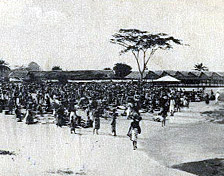In the Department of African and African American Studies, I developed an introductory course on Muslim women called Women and Islam. This has grown into a large, diversely populated course offered each spring. Because I am not Muslim, I felt it important to offer a forum for Muslim women’s own voices and created a complementary course, Muslim Women’s Auto/biography, which is offered each fall.
One Woman’s Jihad: Nana Asma’u, Scholar and Scribe, loosely called a biography, is a case study from 19th-century northern Nigeria. Each chapter is organized around a selection from Asma’u’s writings, presented in full in the appendix. One Woman’s Jihad was written for this course as a way of talking about primary documents by a woman scholar.1
I teach One Woman’s Jihad at the end of the course as a counterpoint to the 20th-century testimonies. The case study of Asma’u provides a powerful example of the scholarly endeavors in which many Muslims of the 19th century were engaged. Because many of their stories are as yet undiscovered, or are not translated, the Western world is unaware of women like Asma’u, but she is not unique. Islam has provided fertile ground for the pursuit of knowledge by women as well as men.
Students establish a foundation for One Woman’s Jihad on two levels. First, they read and discuss an introductory text on Islam. Second, students bring that introductory knowledge to the level of interpretation. They examine how women’s lives and choices reflect their values in relation to Islam. Students question whether actions or perspectives reflect “ideal” or “real” Islam.
Thus, by the time the students read Asma’u’s story, they have developed an understanding of Islamic precepts, and more importantly, the ways in which women interpret Islam in their own lives, circumscribed by gendered responsibilities. This provides students with a contextual foundation for their interpretations of Asma’u’s accomplishments and stated values. I offer additional context by explaining some details about life in 19th-century and contemporary Hausa culture. Students are free to ask questions, but are not required to do additional research on the topic.
I ask students to list questions concerning the conditions under which Asma’u lived, the ways in which she practiced Islam, the aspects of Islam she felt to be most important as demonstrated by her actions, and comparative perspectives on her life in relation to the Muslim women’s lives about which they had already read. What most surprises students is that this was an African Muslim woman; most students hold the stereotype that associates Islam with the Middle East. They are also curious to know how exceptional Asma’u was. That she taught cadres of other women teachers of women surprises them, and helps to confirm the notion of the importance of education in the average Muslim individual’s life. In addition, students have little idea of women’s roles in African history. This case study of a woman close to the heart of significant historical events changes their perspectives on West African history. Their questions concern Asma’u’s daily obligations, the practical aspects of her life, and the degree to which she was respected in her time. They are surprised to learn that she taught not only women but men as well, was renowned by scholars as far away as the Maghreb, and was selected to catalog her illustrious father’s library of hundreds of volumes in four languages after his death. This honor attests to her reputation as an accomplished, multilingual scholar.
In this course students acquire more than just reading life stories by contemporary Muslim women would afford. First, they acquire critical insights to evaluate the ways in which Islam is portrayed in a wide range of media, considering whether the message conveyed is meant to reflect the ideal, the real, or a stereotype. For any number of cultures there is a common foundation of the “ideal” Islam that everyone tries to follow coupled with the “real” Islam that comes from diverse contextual interpretations. When the image reflects the “real,” they understand that one needs to consider the particular cultural context of the situation to best comprehend how Islam appears to be practiced. Within that “real” Islam, there are also subcategories, largely based on divergent gender-based interpretations.
Second, students learn that not all historical information is readily available. Understanding that unwritten history is as valid as published sources is news to many students. The concept that Asma’u’s story is but one example tends to revise students’ definition of history. When I remind them that ten years ago most of the autobiographies read in this course were not yet published, they begin to see that history—and publication—is political.
Each year that I use this book, I feel inclined to drop it, and we discuss this prospect in class. Students recommend continuing its use, saying that they were amazed to learn that such a woman existed. More importantly, however, they acknowledge that the case study provided a new perspective on history, and changed the ways in which they recognize and analyze historical materials.
1 Beverly B. Mack and Jean Boyd, One Woman’s Jihad: Nana Asma’u, Scholar and Scribe (Bloomington, Indiana: Indiana University Press, 2000). For more poems by Nana Asma’u, see Jean Boyd and Beverly B. Mack, The Collected Works of Nana Asma’u, bint Usman dan Fodiyo 1793-1864 (East Lansing, Michigan: Michigan State University Press, 1997).


